1lumen selects and reviews products personally. We may earn affiliate commissions through our links, which help support our testing.
Haikelite HK08 review
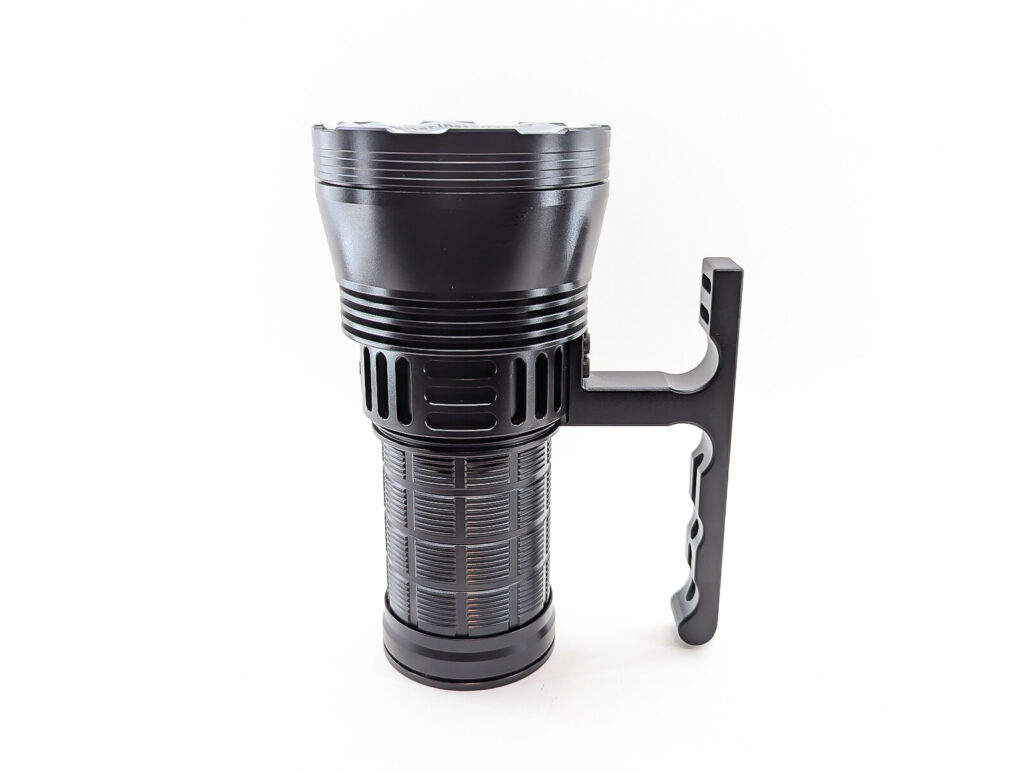
Haikelite HK08 specs
| Brand & Model | Haikelite HK08 |
|---|---|
| Flashlight category | Brightest flashlights |
| LED | SFH43 (x8) |
| Max. output | 60,000 lumens |
| Max. beam distance | 1,340 meters |
| Max. beam intensity | 450,000 cd |
| Battery config. | 4x 21700 |
| Onboard charging | USB-C |
| Main modes | 4 |
| Blinkies | “Burst” (medium strobe), SOS, “tactical flashing” (fast strobe) |
| Waterproof | IPX6 |
| Review publication date | September 2023 |
Review intro:
From what I’ve seen of HaikeLite over the past few years, the company has one goal: to put out as many lumens as possible. Pretty much every flashlight they make seems to be a lumen-monster. The Haikelite HK29 that I previously reviewed certainly matched that description: it packed a whopping 29 LEDs to make one intense, floody beam. The HaikeLite HK08 that is up for review is even more ludicrous, it has 8 monster SFH43 LEDs, each of which have 16 dies. That all adds up to a boatload of lumens… more than I’ve ever witnessed from a flashlight. Intrigued? Me too!
Package quality.
The HaikeLite HK08 arrived in a nice, 2-part white cardboard box with minimal branding on the outside. The inside was filled with black foam and a lot of goodies. Inside the box was:
- HaikeLite HK08
- Carrying strap
- Two charging cables
- Spare o-ring
- Manual
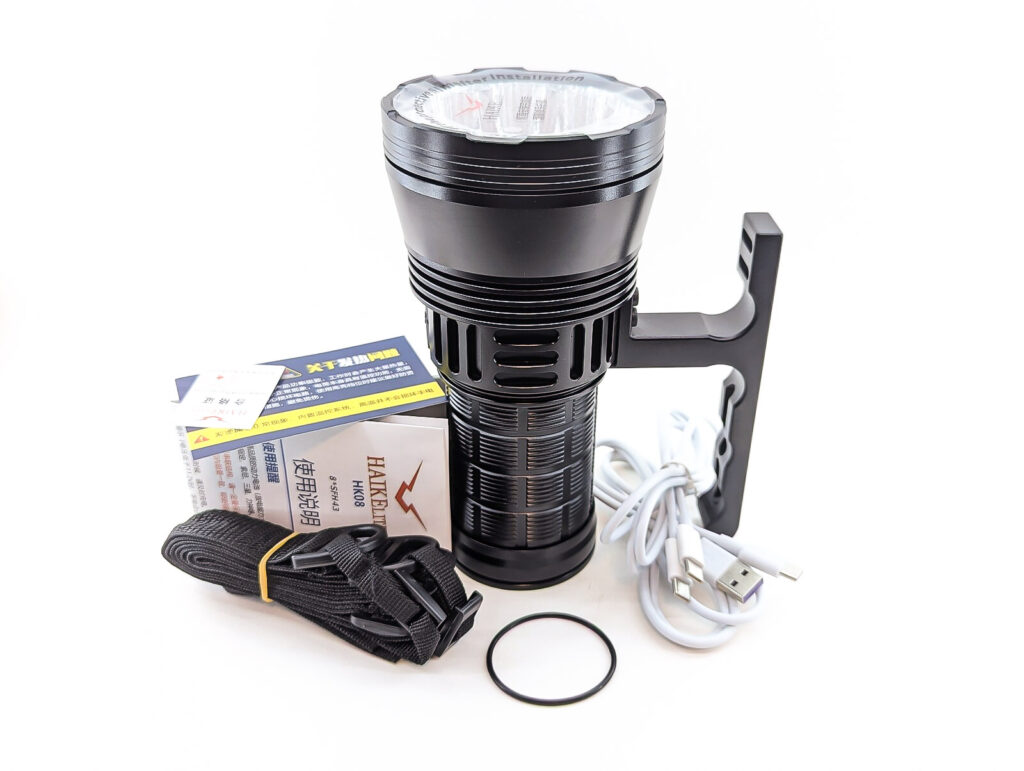
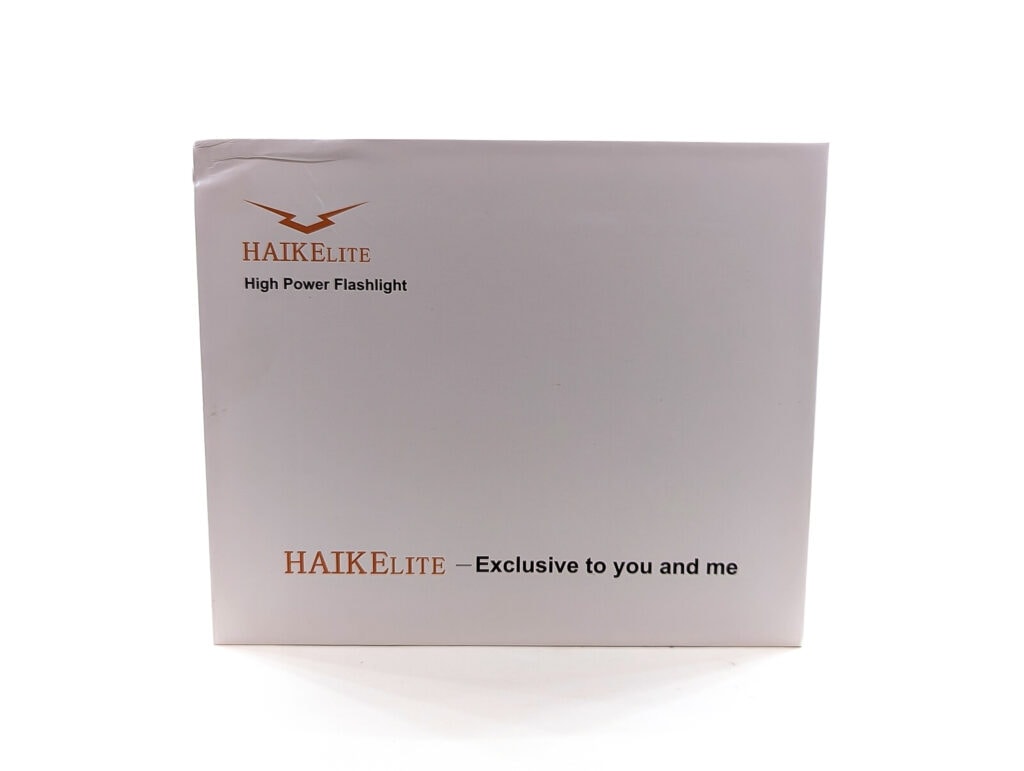
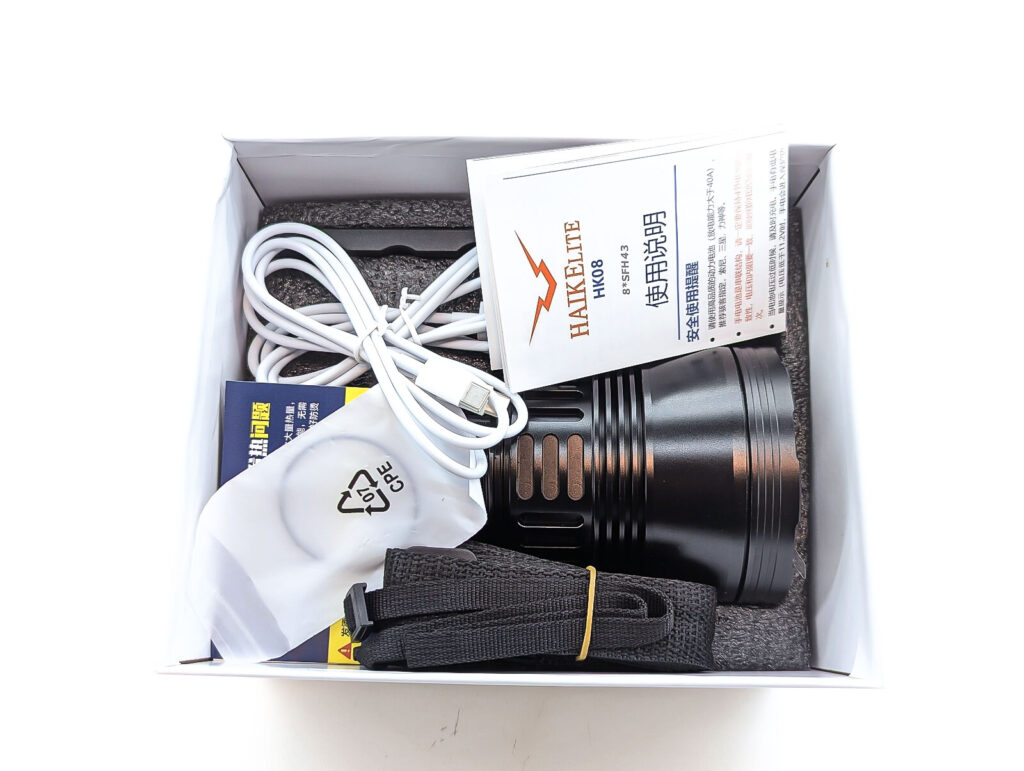
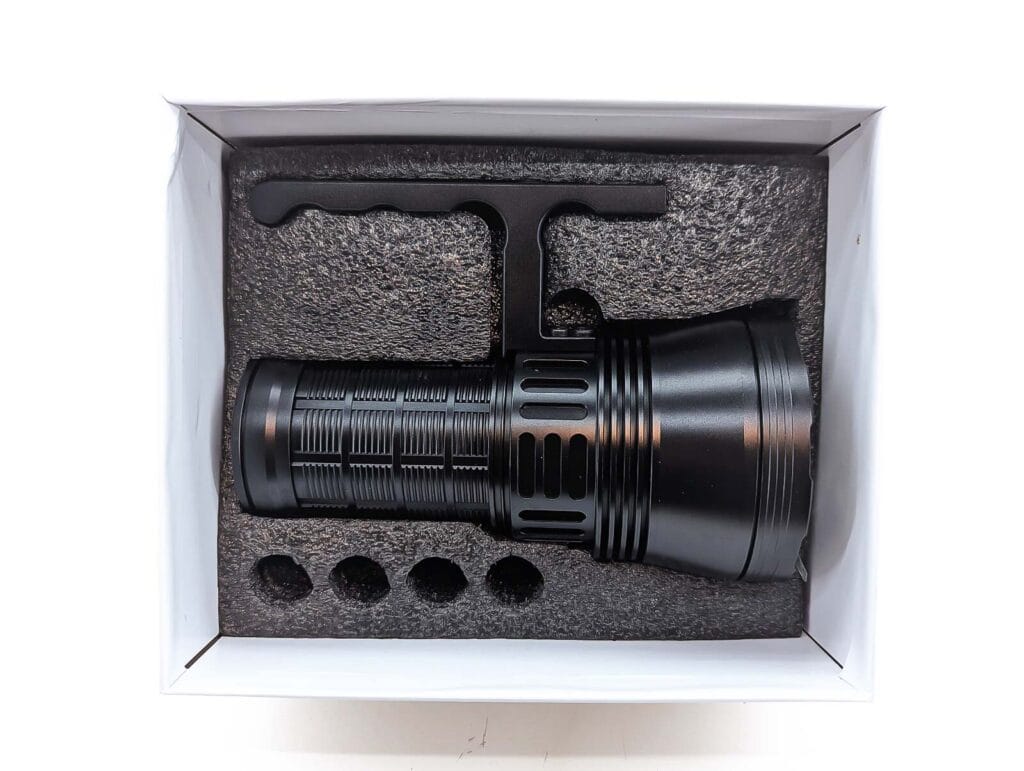
Flashlight in use
The HK08 is a chunk! You could potentially hold it with your hand, but it is large enough that I can’t wrap my fingers around the body. And honestly, this thing gets so hot during operation that you don’t want your fingers on that battery tube. Thankfully HaikeLite built a handle into the flashlight. That handle is meant to stay there permanently, too, because the lone e-switch is built right into the handle.
Due to the handle, it isn’t allowed to roll around too much. And the tail is very flat, so it’s quite stable for tail standing in case you need to light up an entire auditorium during a power outage. Which brings me to how you might make use of 60,000 lumens. You can make an entire parking lot look like daylight. Or if the lights happen to go out at a major sporting event and you somehow made it past security with the HK08 – you might just save the day (or get tackled by a guard… let me know how that goes for you). It’s also powerful enough that you could probably cook your dinner over it in a pinch.
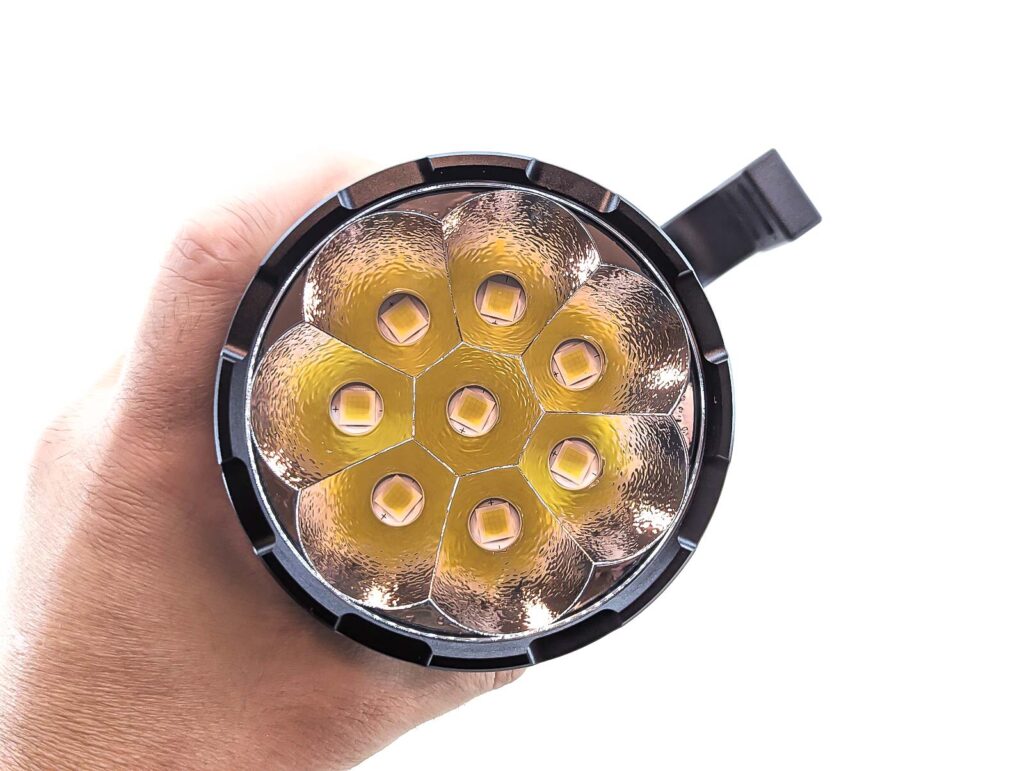
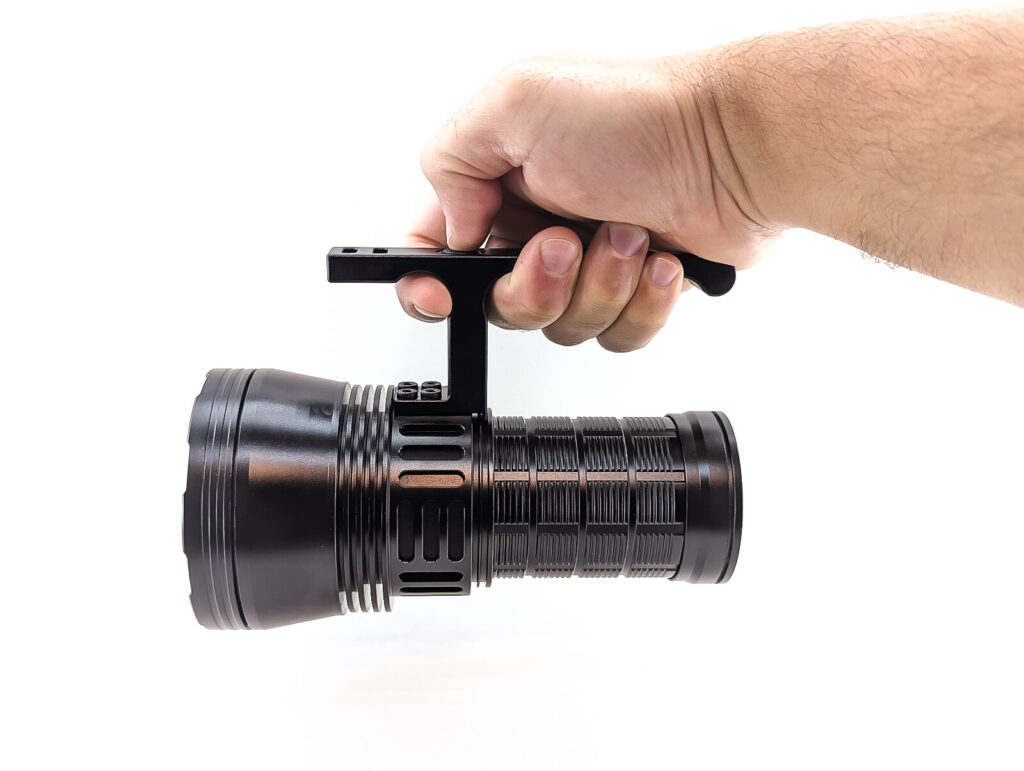
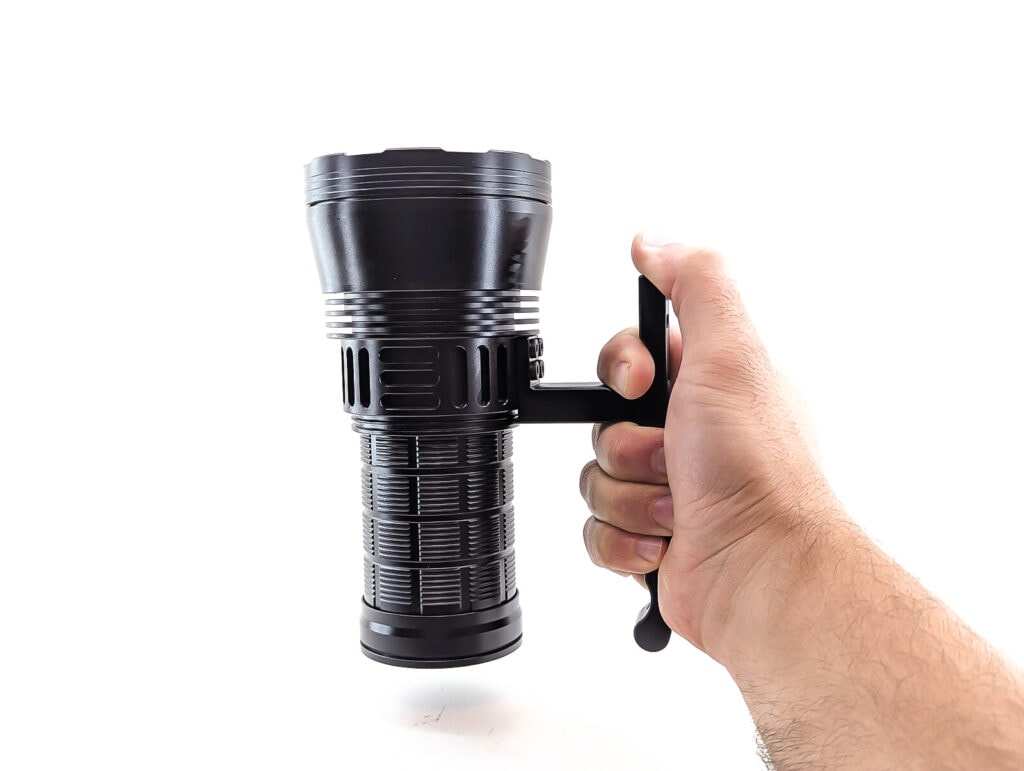
Build Quality and Warranty
According to NealsGadgets, the HaikeLite HK08 is made of 6063 aircraft aluminum. While it sounds fancy and all, that’s pretty standard but good. Neal also says that the coating is Hard Anodized Type III. That’s plausible, I suppose, but I am somewhat skeptical when any company I’m not familiar with claims HAIII. I’m not an anodizing expert so I’m not one to refute it I guess. The coating is on the shiny end of the spectrum. Which, to be honest, I usually associate with cheap lights with less than stellar quality. I’m not saying that HaikeLite’s anodizing is bad – it’s very even and clean.
The machining is on the “blocky” side of things, which is befitting a flashlight of this stature. The battery tube has a square pattern with thin lines running its circumference. Overall, the HaikeLite HK08’s design and build quality seem… fine. There’s nothing wrong with it, it just doesn’t seem as inspired or refined as some other designs out there.
Warranty… that’s a good question. I don’t see anything about the warranty policy. If you buy the HK08 from Neal’s shop and you have any trouble, I’m sure you can just reach out to him for assistance.

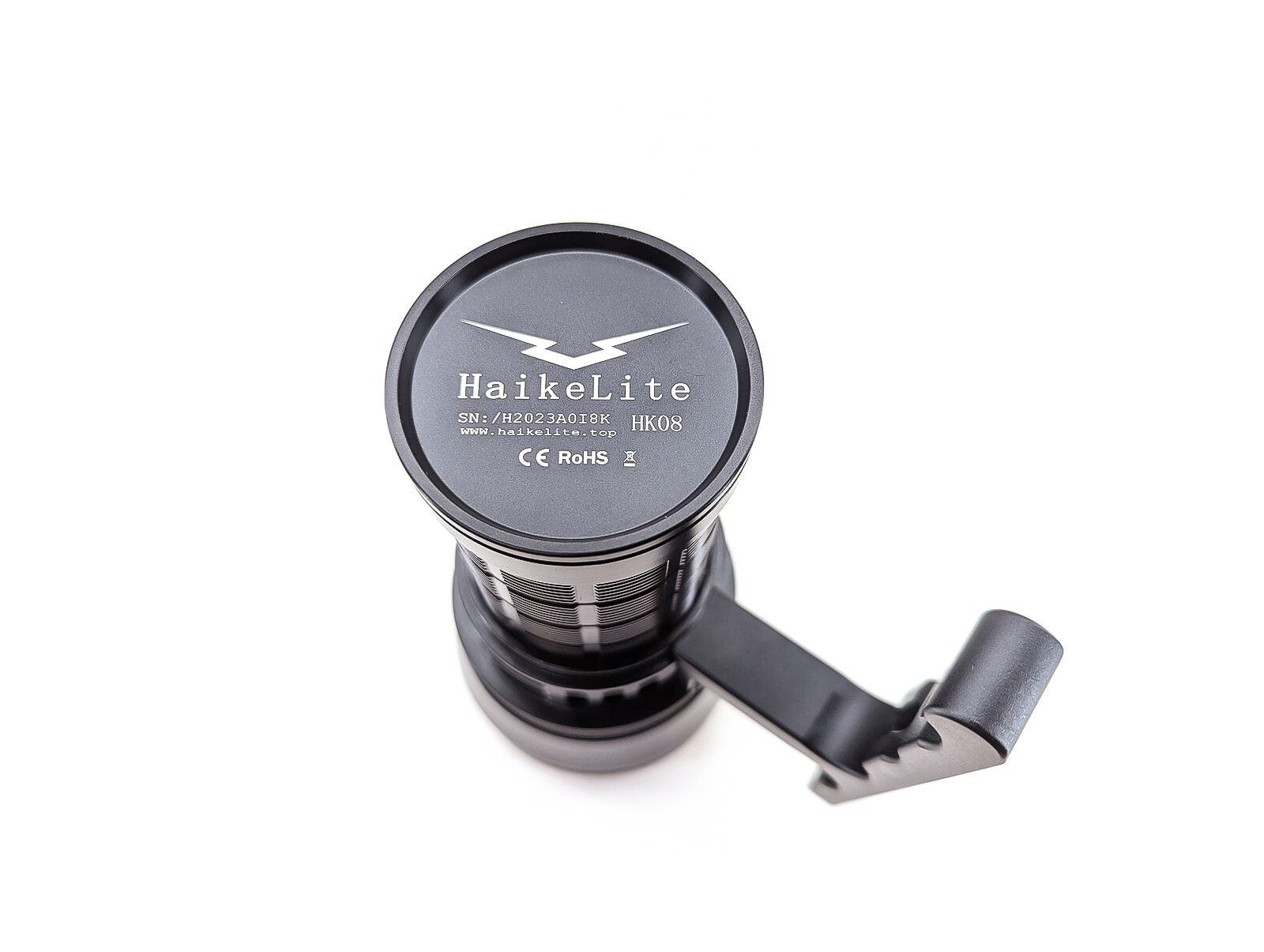
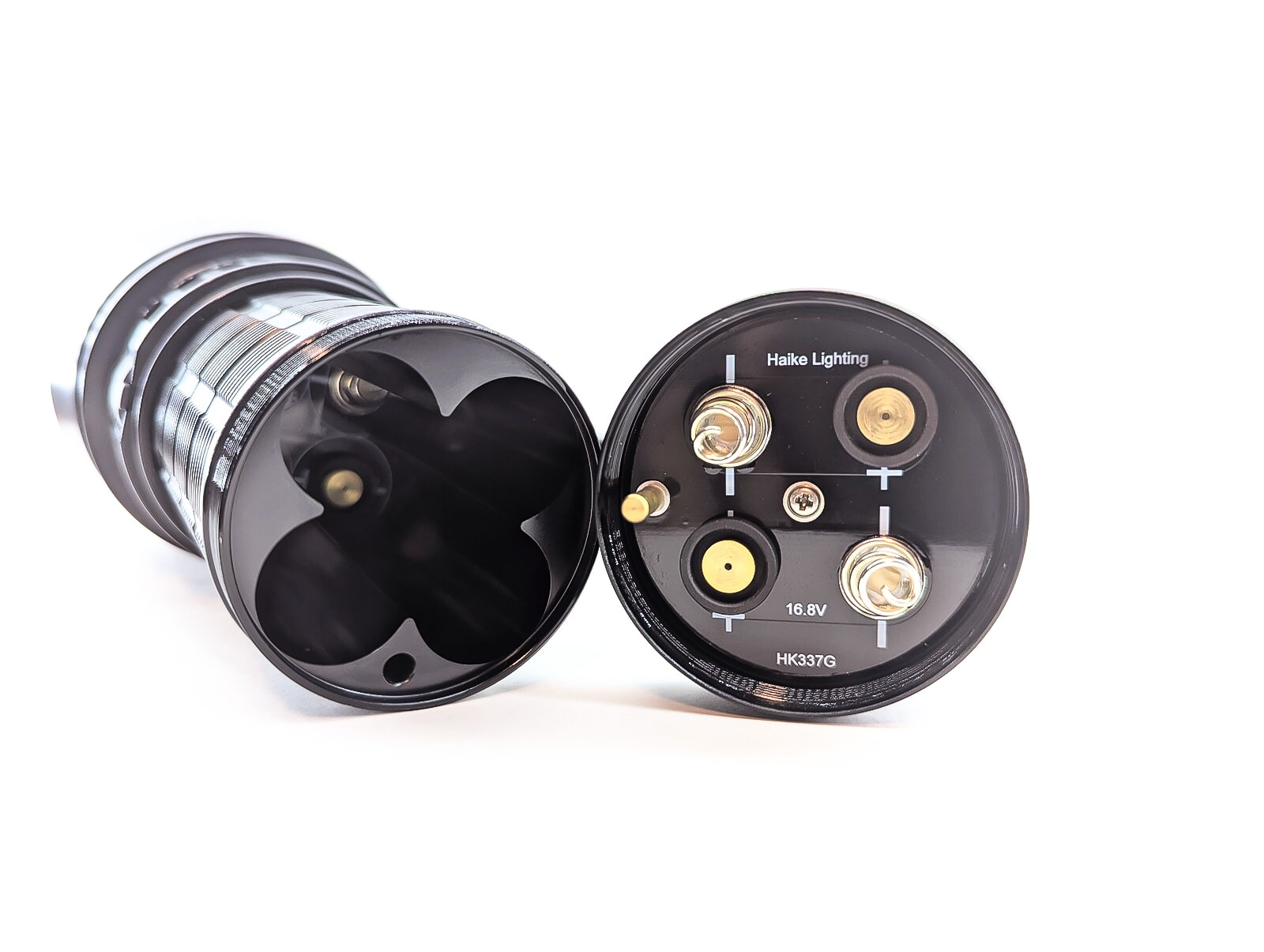
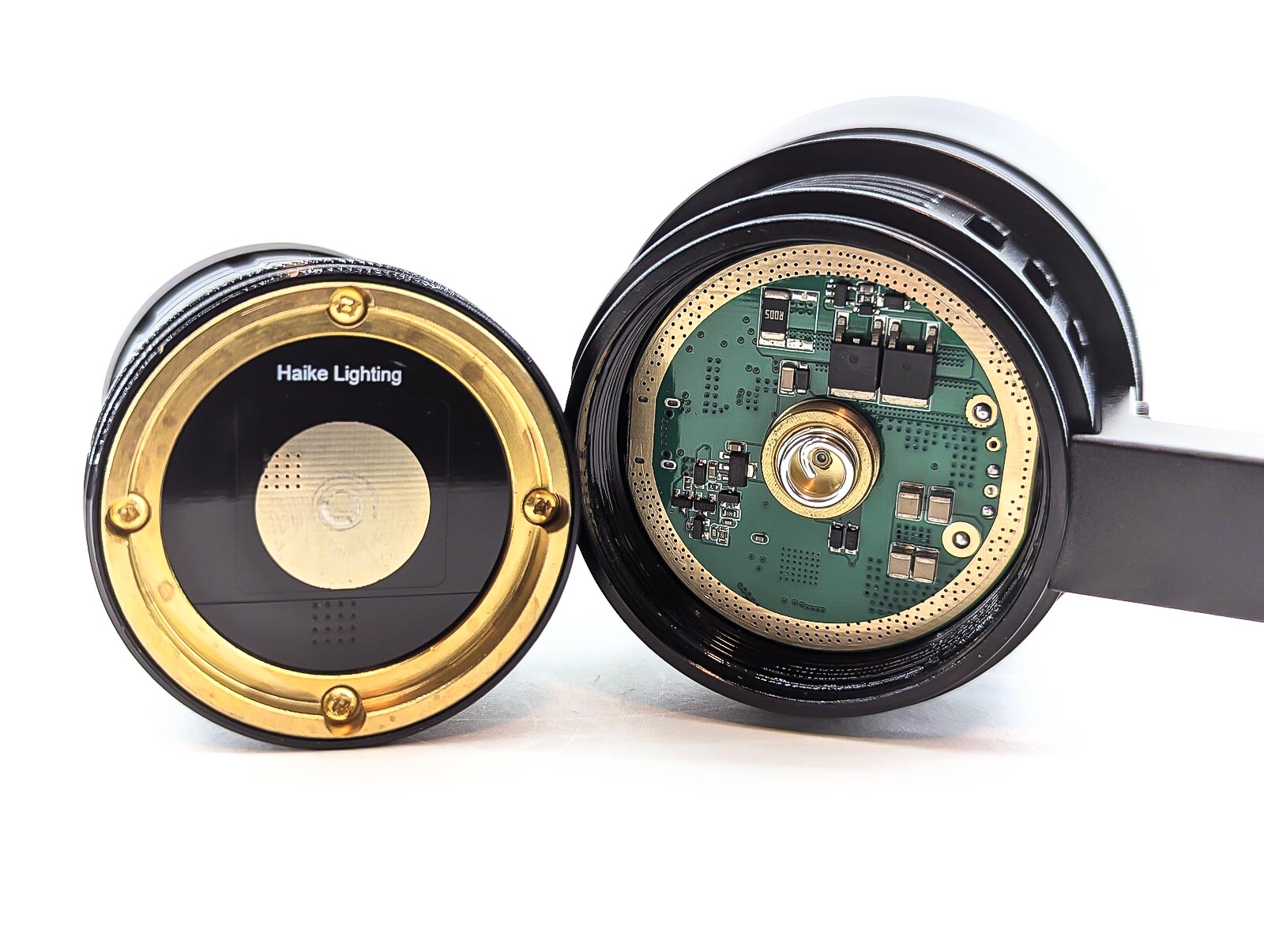
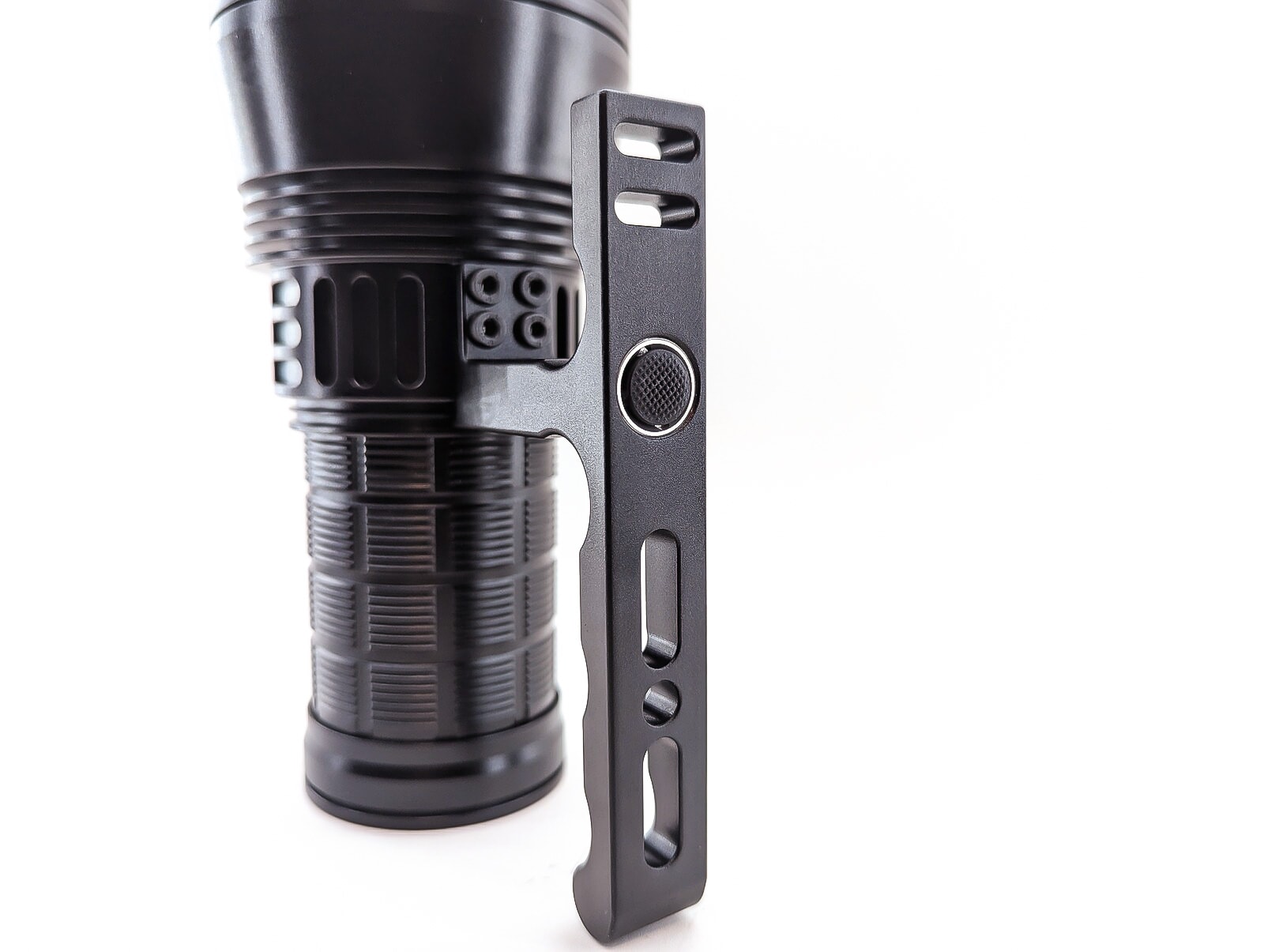
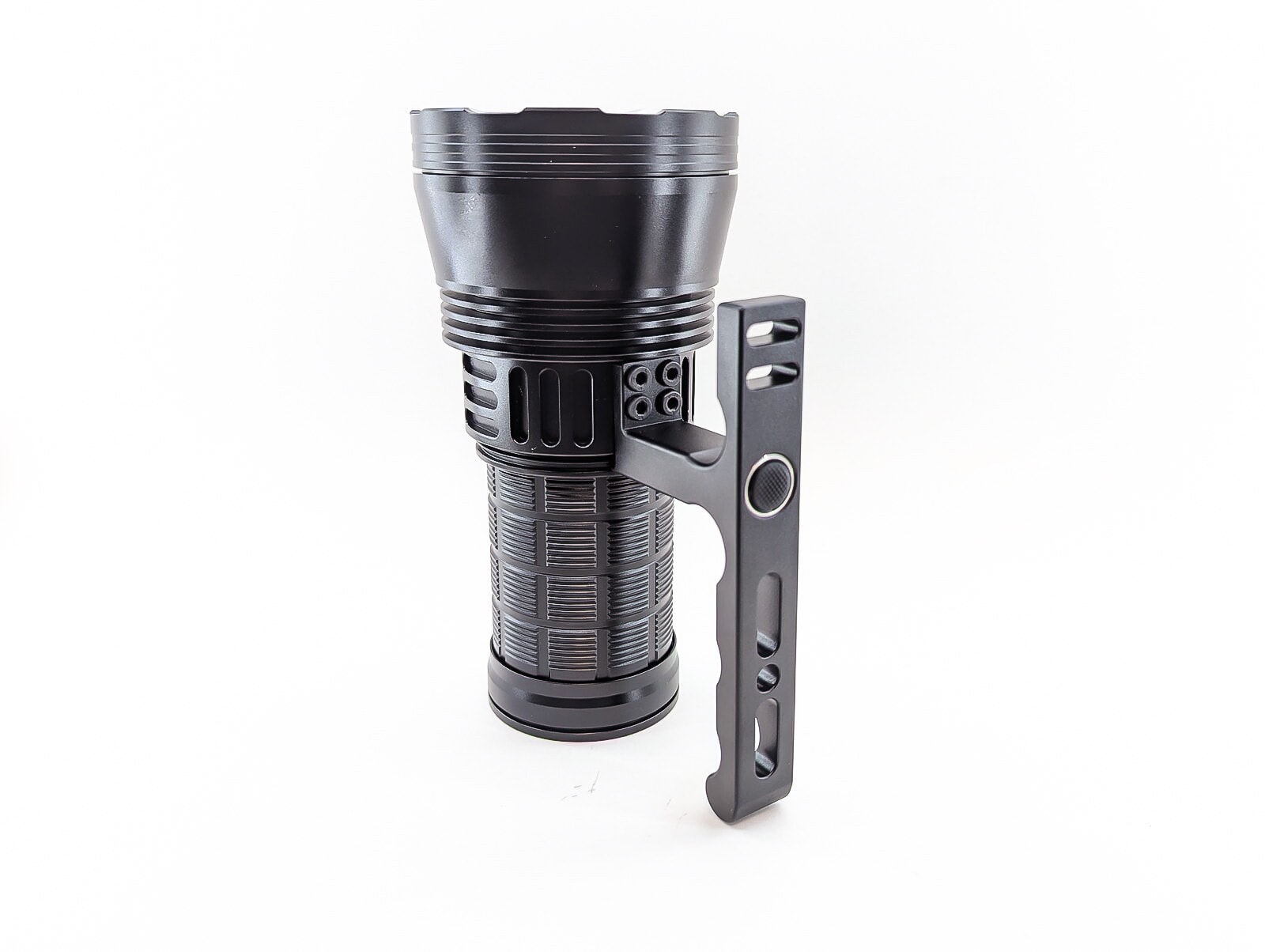
LED, Lens, Bezel, Beam, and Reflector
The bezel is anodized aluminum, matching the rest of the light. It has some shallow crenulations. The lens is double-sided AR coated. The HaikeLite HK08 employs an orange peel reflector that is a bit deeper than I expected it to be. That helps out some with increasing the throw figures – it actually throws better than I imagined for an 8-LED light. In each pocket of the reflector is nestled a big SFH43 LED with 16 dies. Each one of those LEDs can theoretically put out 9,500 lumens. So 8 of them must be good, right? (Spoiler – yes, it’s very impressive)
Measurements from the Opple Light Master at 5m on Turbo:
- CCT: 6488K
- CRI: 70.4
- DUV: -0.0002
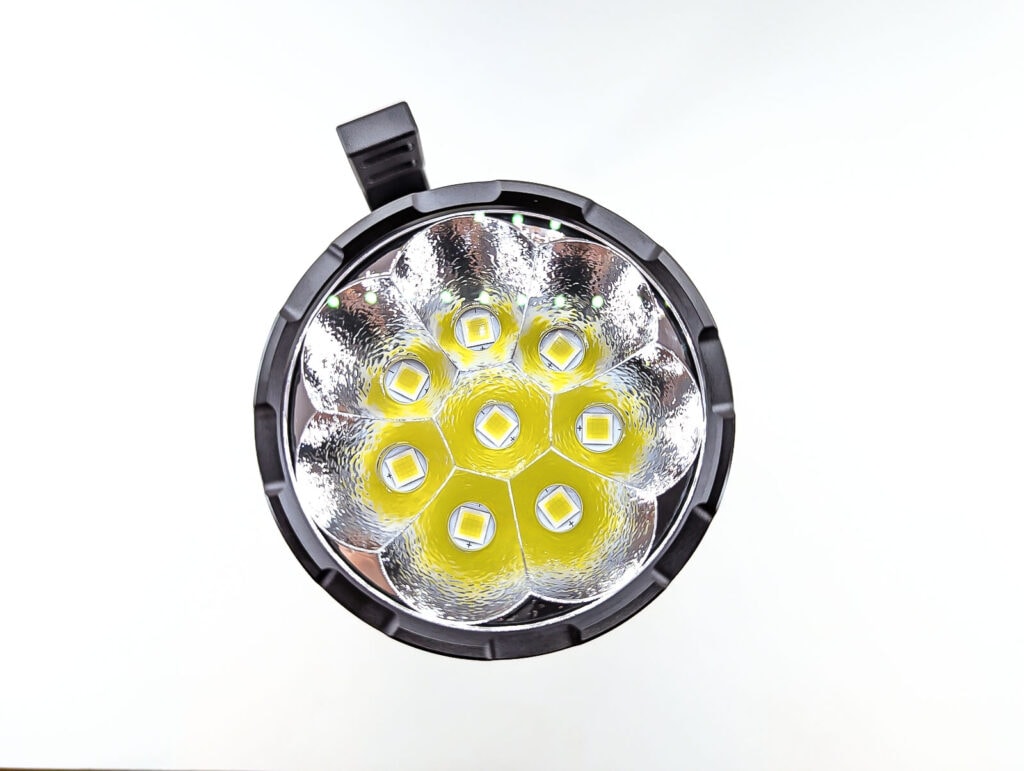
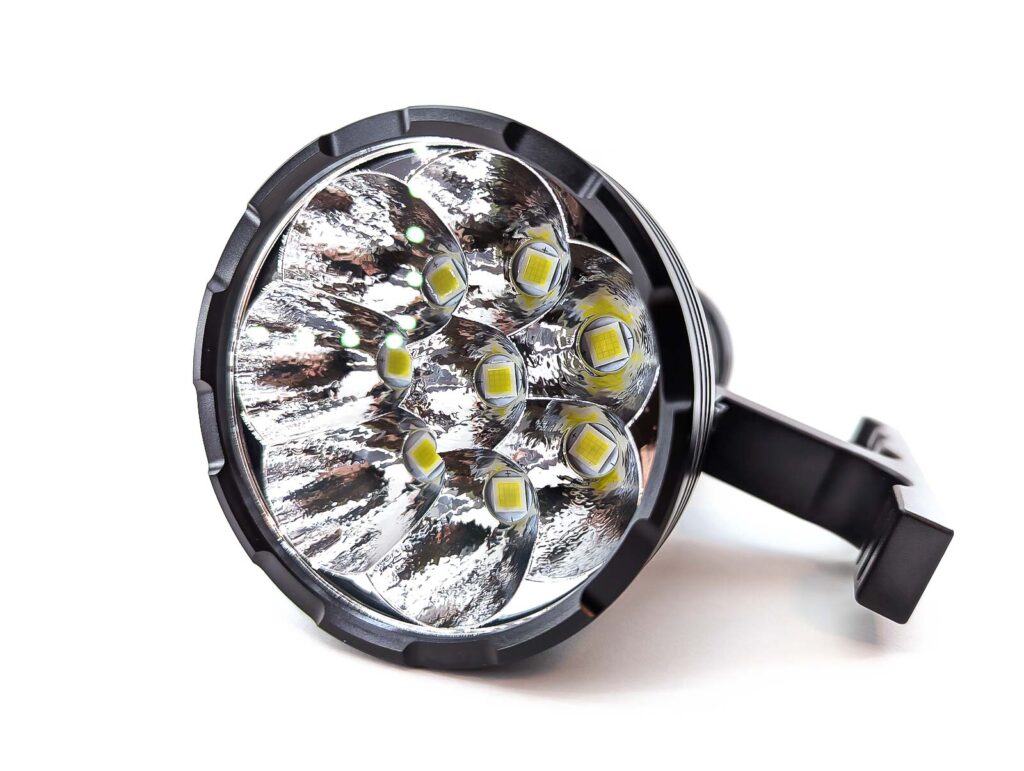
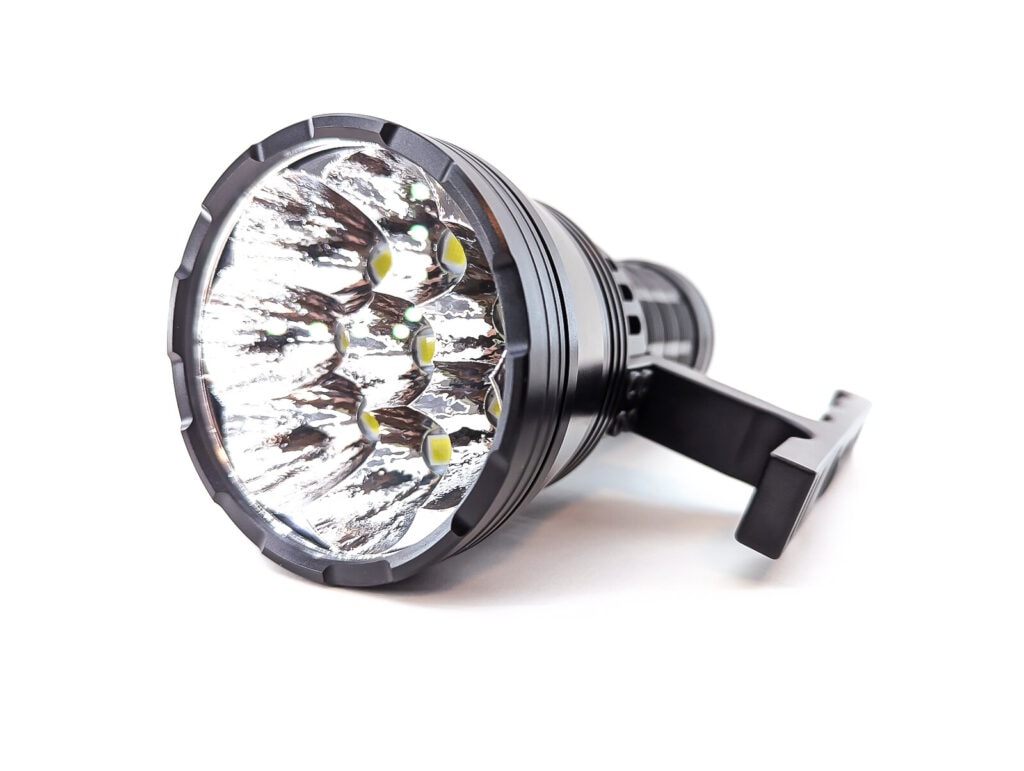
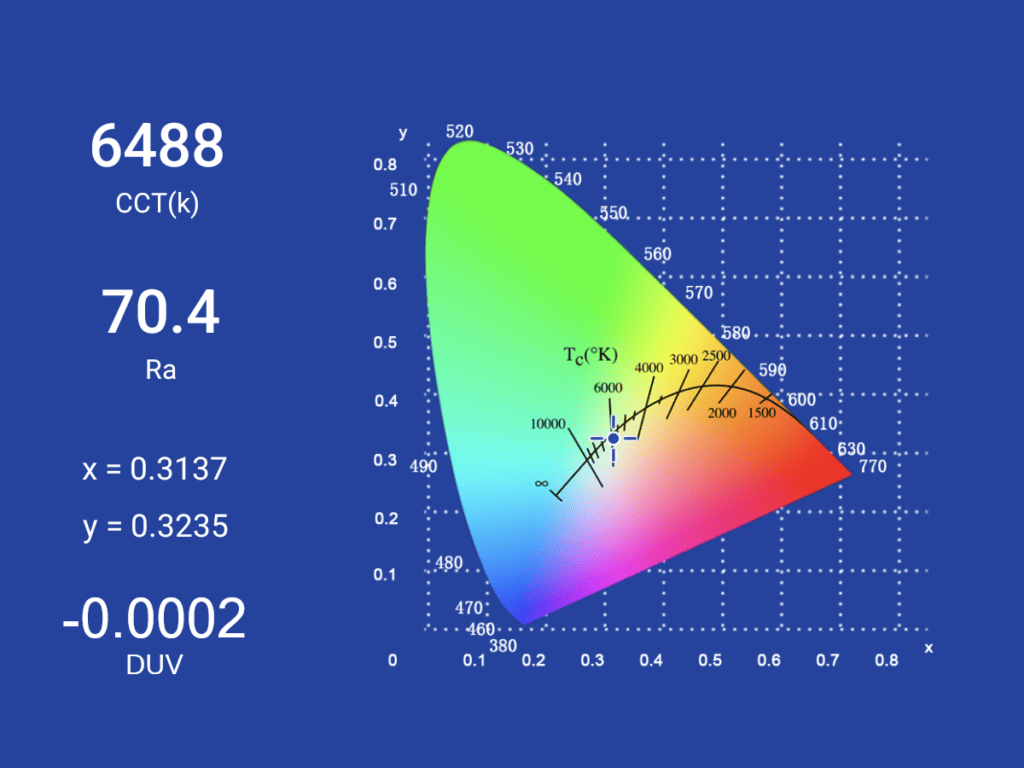
Dimensions and its competition
| Haikelite HK08 | Millimeters | Inches |
|---|---|---|
| Length | 177 mm | 7.0 in |
| Head diameter | 90 mm | 3.5 in |
| Body diameter | 57 mm | 2.2 in |
Dimensions are rounded to the nearest millimeter, and to the nearest tenth of an Inch.
Weight:
| Haikelite HK08 | Weight in grams | Weight in oz |
|---|---|---|
| Without battery: | 1080 g | 38.1 oz |
| With batteries (4x 40T) | 1367 g | 48.2 oz |
Weight is rounded to the nearest gram, and to the nearest tenth of an Oz.
Flashlight size comparison with its competition:
Group 1: Convoy 3x21A, HaikeLite HK08
Group 2: Astrolux MF01X, HaikeLite HK08

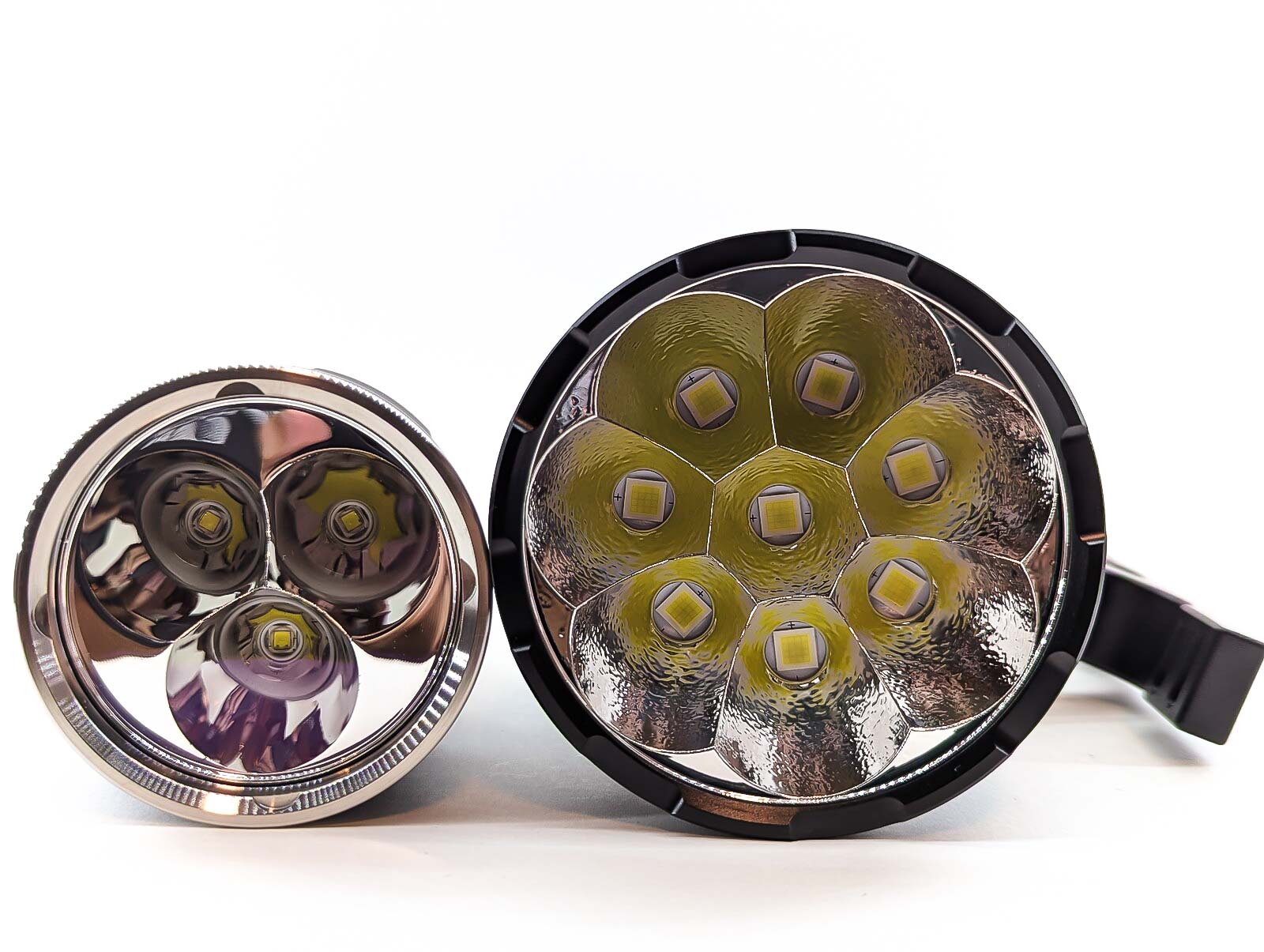
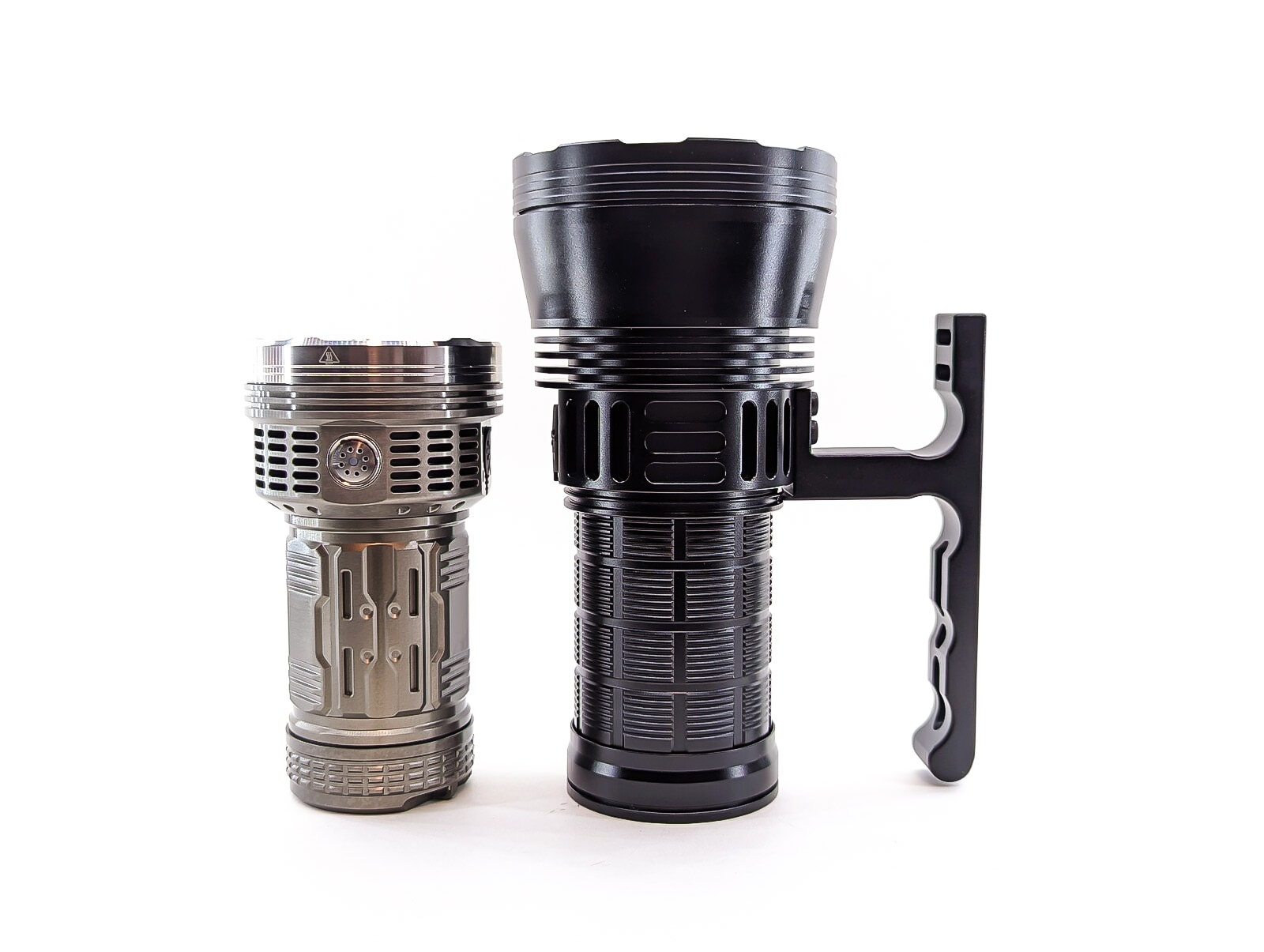
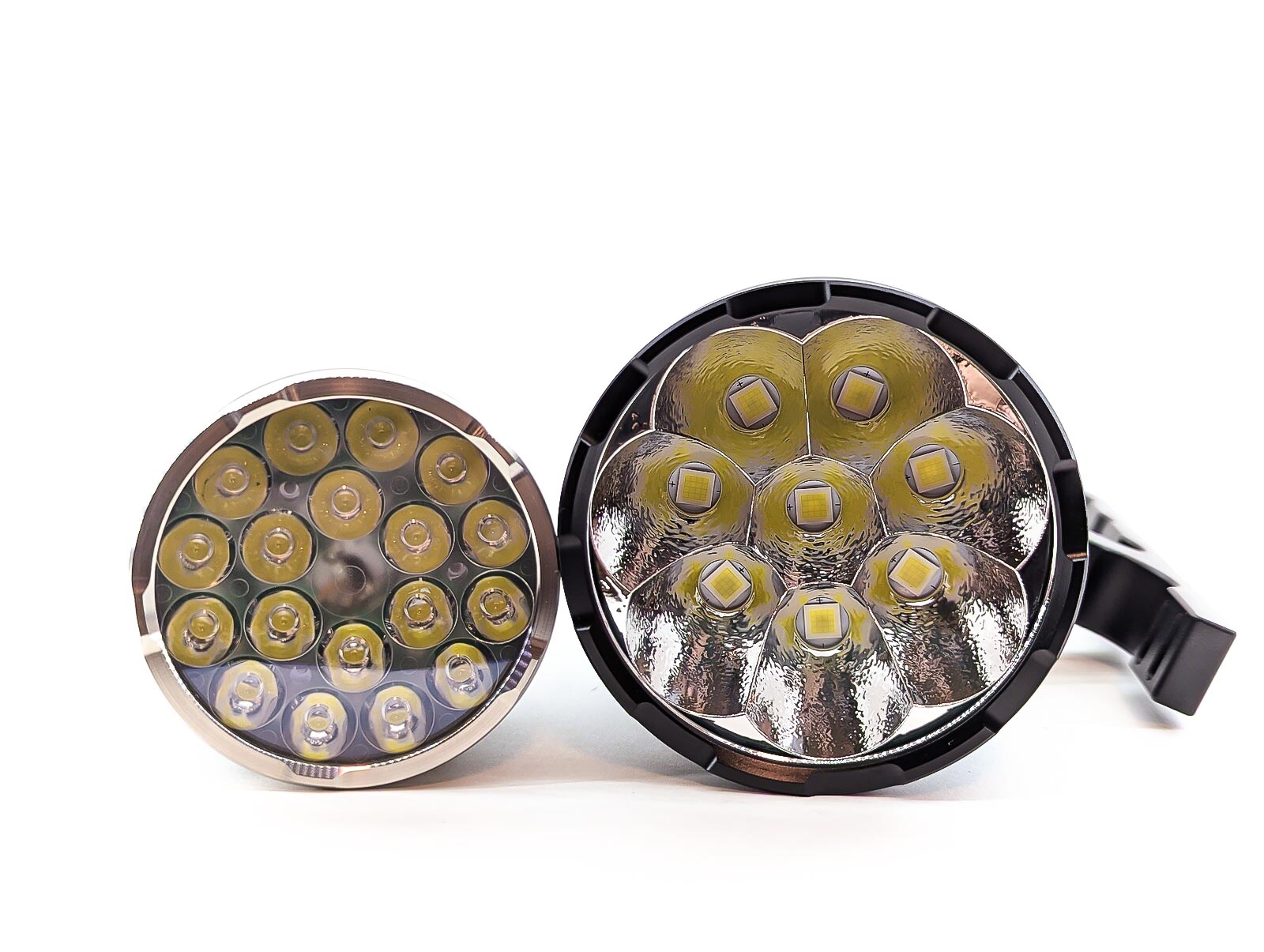
Haikelite HK08 UI: User Interface and Driver
The driver arrives in “infinitely dimmable” / ramping mode, which I immediately switched over to stepped mode for testing purposes. The manual mentions that there are 4 stepped modes (called First, Second, Third, and Fourth) plus Turbo. I find that a bit odd, because mine seems to have 5 stepped modes plus Turbo. To make things even more confusing, the output of the first 3 modes seems to change depending on if I get to that mode by (1) rotating through the modes by holding the button, or (2) turn the light off and back on in that mode. That is to say, if I go to change modes to Level 2 and measure the output, I get around 6100 lumens. But when I turn the light off and then back on, I measure around 2100 lumens. That’s the first time I’ve ever seen that behavior on a flashlight, and it took me a bit to figure out what was going on.
Available modes:
- Level 1, 2, 3, 4, 5, and Turbo
Available blinky modes:
- “Burst” (medium-speed strobe), SOS, and tactical flashing (fast strobe)
From OFF:
- Press and hold 3 seconds: lockout
- Single click: turn on, last used mode
From ON:
- Press and hold: change brightness
- 1 click: turn off
- Double click: Turbo
- 3 fast clicks: switch between ramping/stepped modes
Mode memory:
- Yes, the normal brightness level are memorized
Shortcuts:
- To Turbo: double click
Low voltage warning/protection:
- There is an indicator LED under the button
- When the battery is below 12.8V the blue light flashes
- Below 12V, red light flashes
- Below 11.2V, the light with shutdown
Strobe/blinkies
- From Turbo, double click to get to Burst (medium-speed strobe) mode
- From Burst, double click to get to SOS mode
- From SOS, double click to get to Tactical (fast strobe) mode
- Click at any point to exit
Lock-out mode:
- Hold 3 seconds from Off to lockout
- Hold for another 3 seconds to unlock
PWM
- 39.8 kHz PWM was detected
Additional/summary info on the UI:
- There is thermal regulation that ramps the output down to around 4000 lumens, but no lower (even then, it gets crazy hot)
Haikelite HK08 Charging and batteries
The HaikeLite HK08 takes four button-top 21700 batteries. There doesn’t seem to be an overabundance of unprotected button-top 21700’s around, so I used some solder-blobbed Samsung 40T’s. Note, you’ll want unprotected cells due to the high-drain nature of this flashlight.
The HK08 specs say that it has 100W USB-C charging/discharging. I thought that had to be a typo. Pushing 100W through a flashlight’s USB-C port sounded like a lot (and perhaps a bit overkill) to me. But testing showed that I was able to hit at least 85 watts (4.32 A at 19.68 V) of power when charging. I was able to fully charge the four Samsung 40T cells in 1 hour and 7 minutes. I probably wouldn’t want to charge my batteries that fast on a regular basis, but I guess it’s good to know that you could if you wanted to. And if you don’t want to charge them that fast? Just hook it up to a weaker USB supply.
While I wasn’t able to measure the charge rate when using the HaikeLite HK08 as a powerbank, my phone did register as “charging rapidly” which is a good indication of a high wattage.
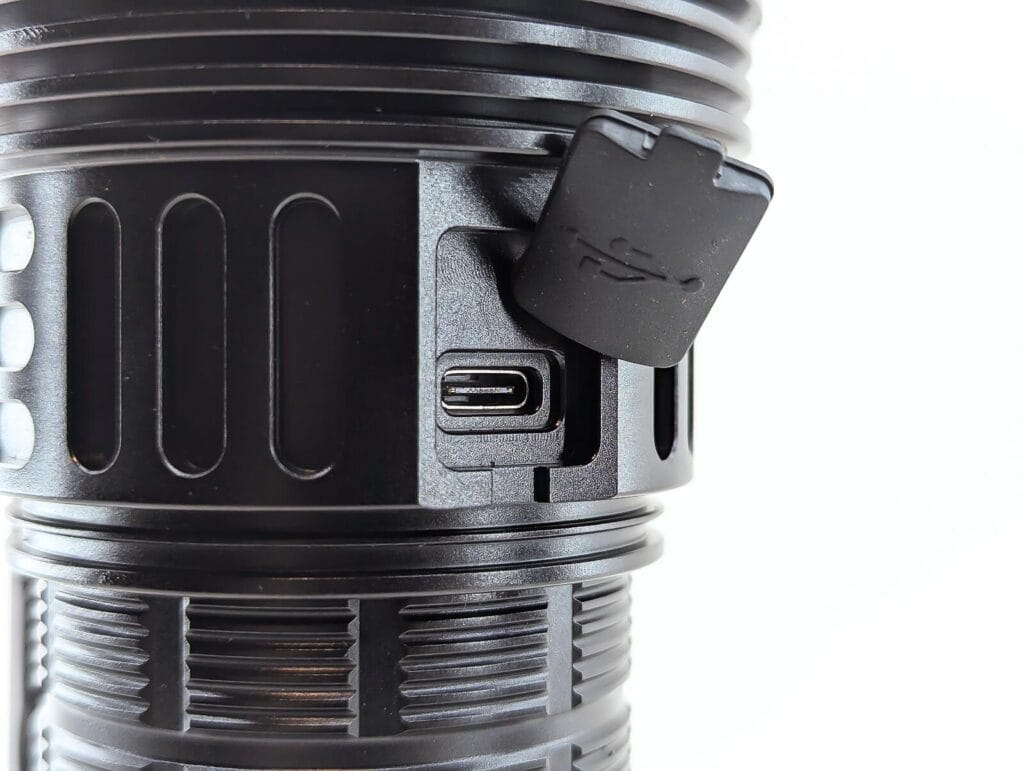
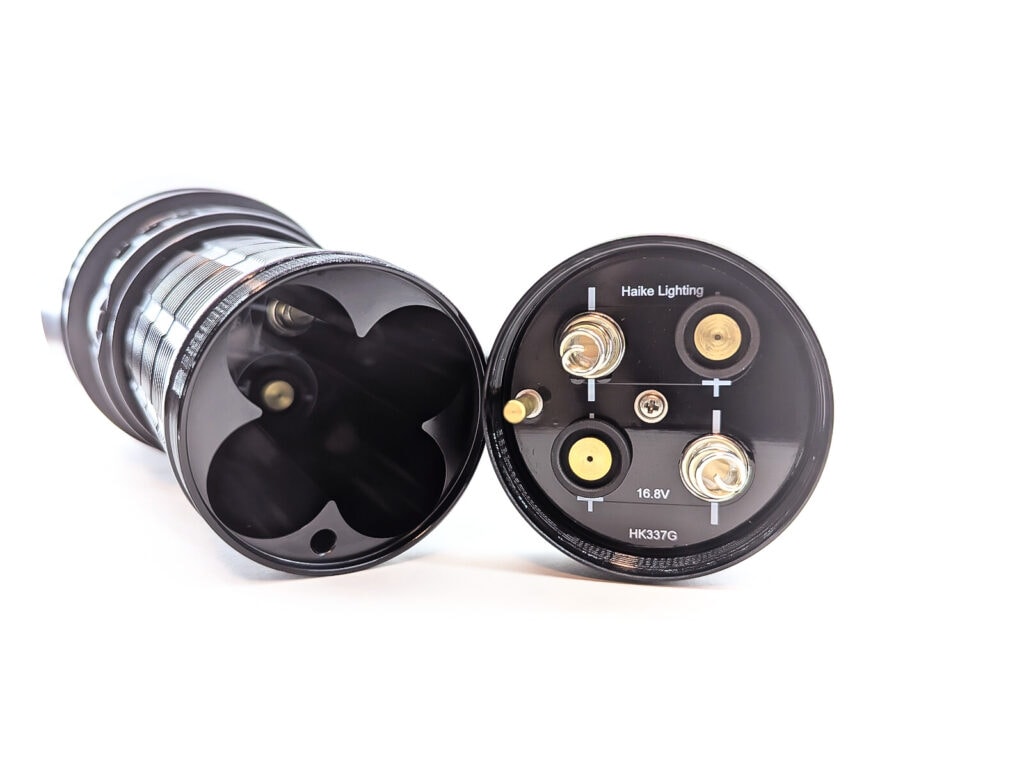
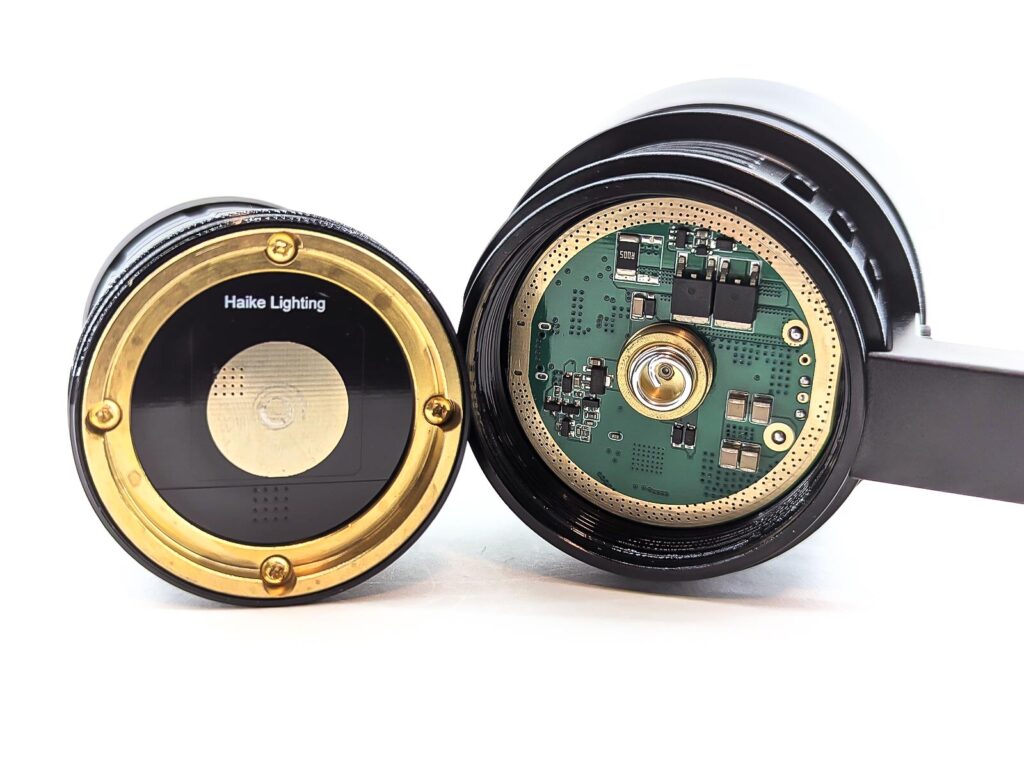
Performance test
Lumen measurements
How Lumens are Measured: Understanding ANSI FL1 Standards How Lumens are Measured: Understanding ANSI FL1 Standards: The ANSI FL1 standards specify that output in lumens should be measured 30 seconds after turning on, as this is the standardized time for measuring brightness according to the industry standard. This is why we focus on this part in our measurements. The ANSI FL1 standards require an ambient temperature of 22 ± 3°C. We record the ambient the ambient temperature to identify potential reasons for any observed discrepancies.Lux was measured by a UNI-T UT383 BT at 10 meters. Lumens were measured in a homemade lumen tube using a VEML7700 sensor, calibrated with a calibration light provided by 1Lumen. Four solder-blobbed Samsung 40T batteries were used for testing.
| Mode | Specs | turn on | 30 sec | 10 minutes |
|---|---|---|---|---|
| Level 1 | 500 | 186 lm | 188 lm | – |
| Level 2 | 6,000 | 6,727 lm | 6,742 lm | – |
| Level 3 | 11,000 | 13,703 lm | 13,720 lm | – |
| Level 4 | 15,000 | 14,487 lm | 13,985 lm | 6,515 lm |
| Level 5 | 17,948 lm | 17,988 lm | 6,369 lm | |
| Turbo | 60,000 | 64,447 lm | 59,727 lm | 3,985 lm |
Parasitic drain:
- N/A – couldn’t test due to the light’s construction
When we’re talking about reality, pushing 60,000 lumens sounds like a tall order. But HaikeLite delivered! As to be expected, the output dropped like a rock after the 1 minute mark (or 2-3 minutes for Level 5 and Level 4). Oh… and despite the drastic drop in output, this thing got hot. The head topped out at an alarmingly hot 86°C and hung out there for quite a while. But that’s why this flashlight has a handle, right? Well, the battery tube was a toasty 75°C and even the handle was an uncomfortable 65°C. I would hope that a flashlight this massive could sustain more than 4000ish lumens without being crazy hot, but I guess that’s too much to ask for.
Haikelite HK08 Battery Life: Runtime graphs
How Runtimes are Measured: Understanding ANSI FL1 Standards About ANSI FL1 runtime standards: The runtime is measured until the light drops to 10% of its initial output (30 seconds after turning on). This does not mean that the flashlight is not usable anymore. The last column shows how long the light actually works till it shuts off. If there is a + symbol, it means that the test was stopped at that particular point, but the light was actually still running. This happens on certain occasions, with certain drivers, firmware, or batteries.| Mode | Specified runtime | Measured runtime ANSI | Time till shut off |
|---|---|---|---|
| Level 1 | 50h | – | – |
| Level 2 | 1h | – | – |
| Level 3 | N/A | – | – |
| Level 4 | N/A | 1h 21min | 1h 22min |
| Level 5 | N/A | 1h 16min | 1h 19min |
| Turbo | N/A | 1m 10s | 1h 17min |
HaikeLite was pretty sparse with what to expect for runtime. The mentioned figures for the lowest modes, but provided no information for the higher modes. Due to the drastic decrease in output the ANSI runtime of Turbo is very short, but it did produce over 4000 lumens for more than 1 ¼ hours. The other modes that I tested didn’t last much longer than that.
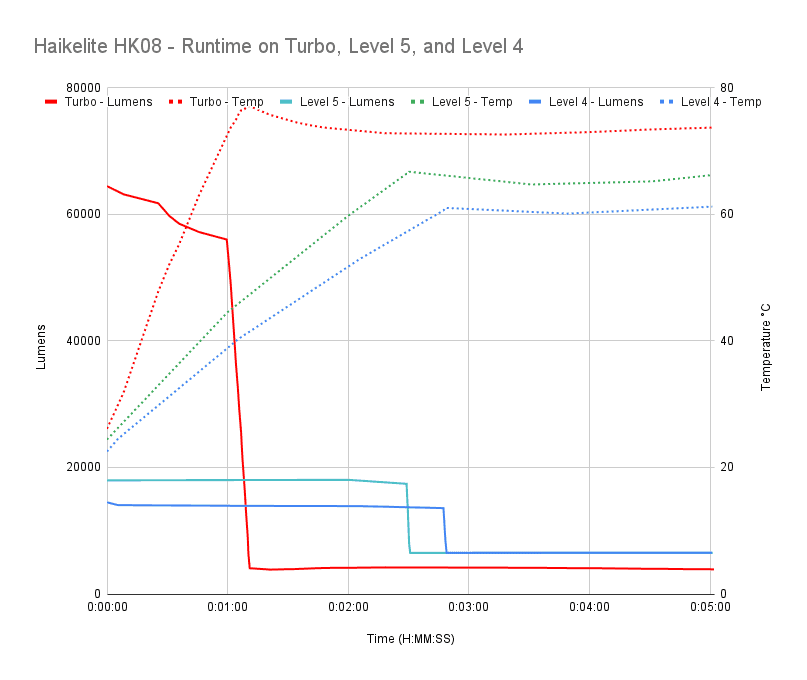
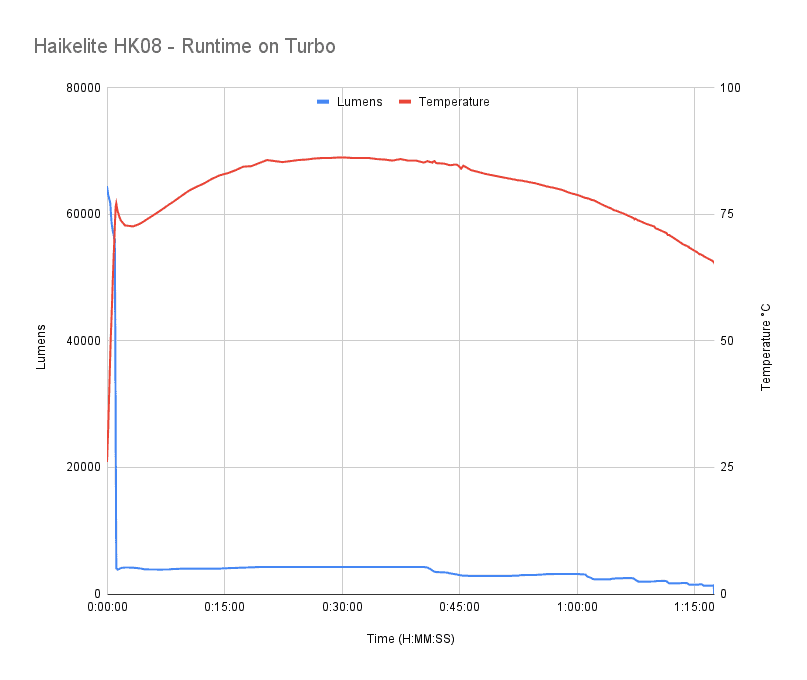
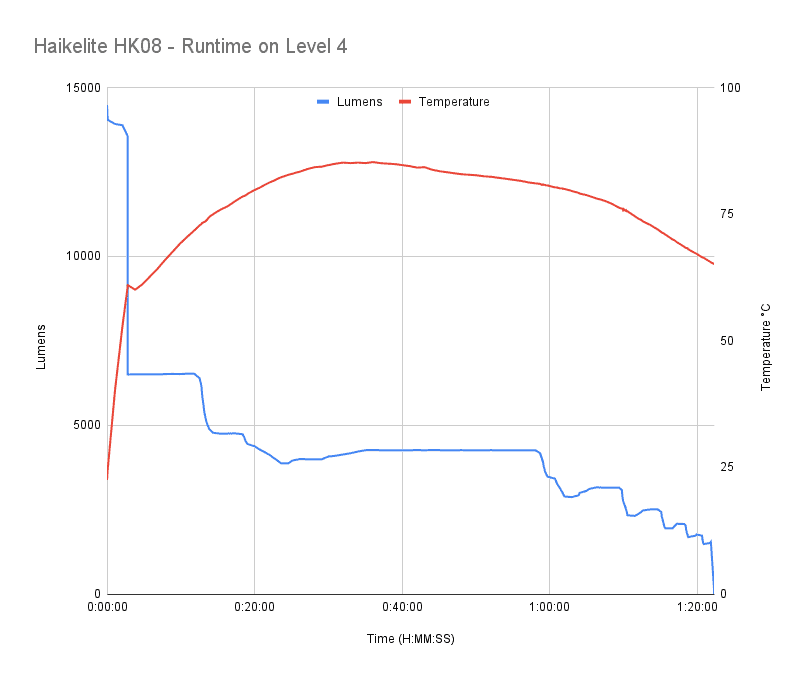
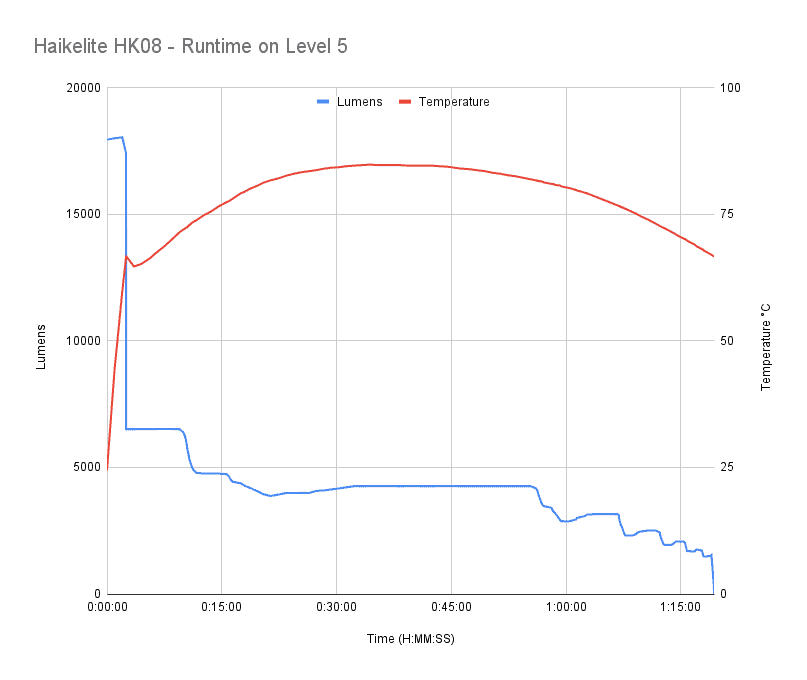
Peak beam intensity and beam distance measurements
About Peak beam intensity: Understanding ANSI FL1 Standards About peak beam intensity The calculated value of distance in meters at which the flashlight produces a light intensity of 0.25 lux. (0.25 lux is about the brightness of a full moon shining on an object). This means that the intensity has decreased so much, it becomes difficult to see darker objects, or objects that don’t reflect light. The columns ‘Meters’ and ‘Yards’ use rounded numbers.Throw was tested at 10 meters with my UNI-T UT383 BT
| Mode | Specs | Candela measured | Meters | Yards |
|---|---|---|---|---|
| Level 2 | 45,600 | 427 m | 467 yd | |
| Level 3 | 74,600 | 546 m | 597 yd | |
| Level 4 | 96,900 | 623 m | 681 yd | |
| Level 5 | 123,400 | 703 m | 768 yd | |
| Turbo | 450,000 cd | 298,200 cd | 1,092 m | 1,194 yd |
While I was able to confirm HaikeLite’s claim of 60,000 lumens, I can’t back up their spec of 450,000 cd. I can give a certain amount of leniency since I’m testing with consumer-grade equipment, but their intensity claim is 50% higher than what I measured. That’s a huge difference.
Beamshots
Camera settings and distance:
Beam shots of the building are taken at 50 m (55 yd) using a Pixel 7 set to ISO 800 with 1/20 second exposure time
Beamshots of the following flashlights compared:
- HaikeLite HK08 – Turbo
- HaikeLite HK08 – Level 5
- Fenix LR40R V2.0
- Lumintop Rattlesnake
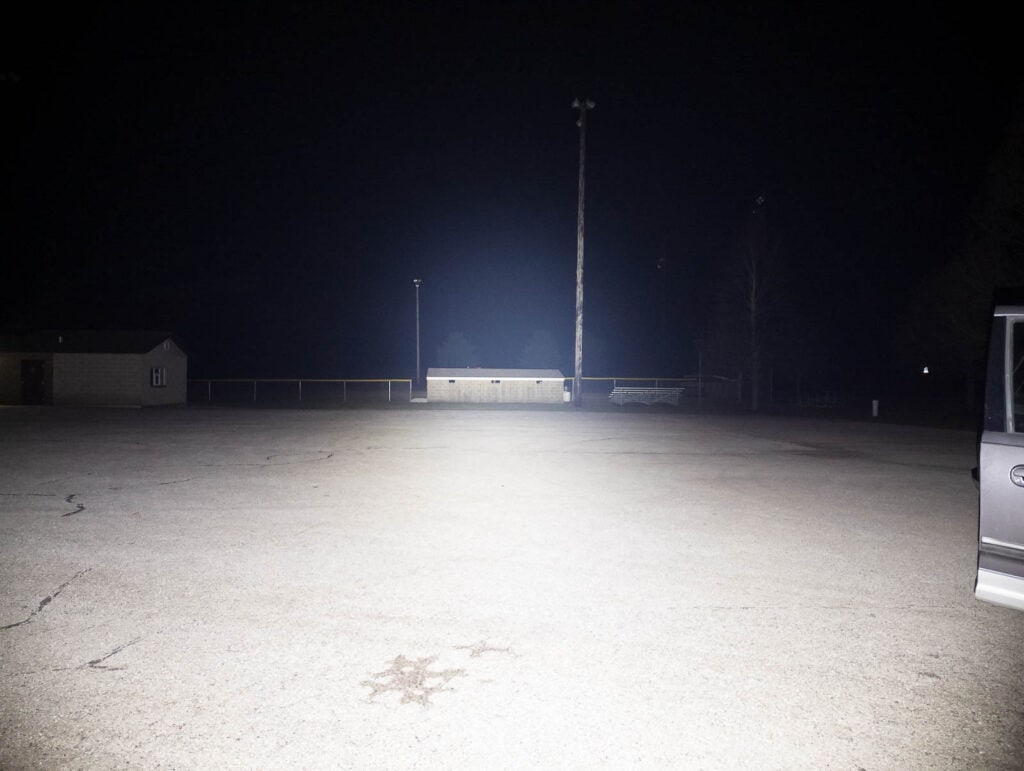
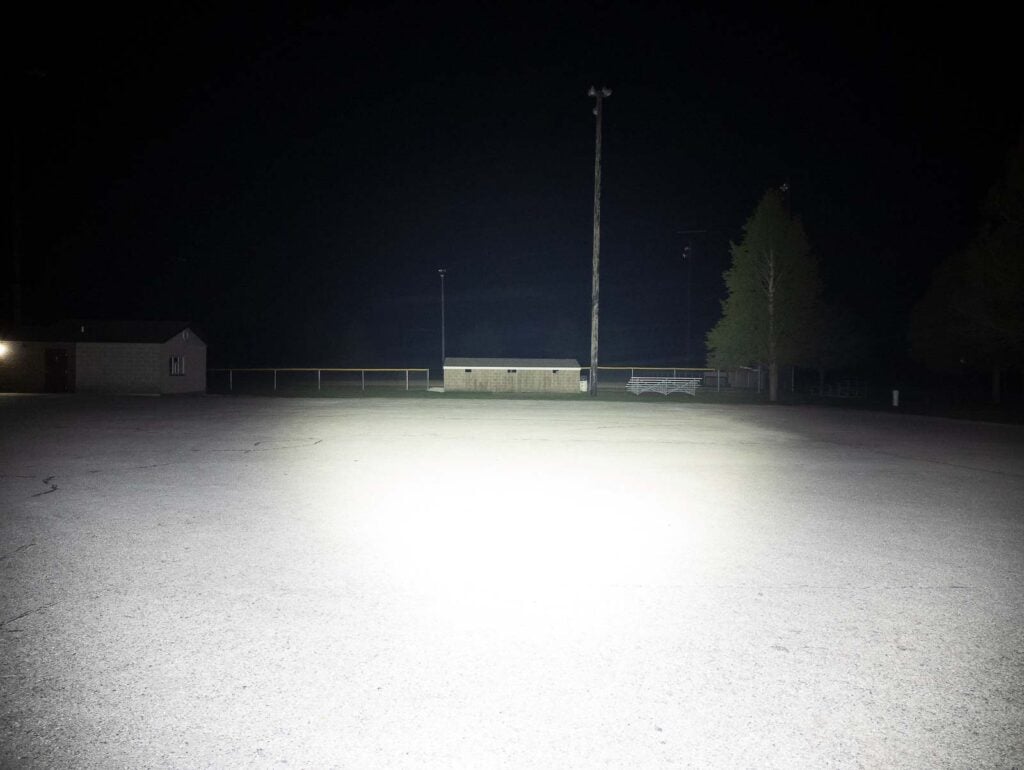
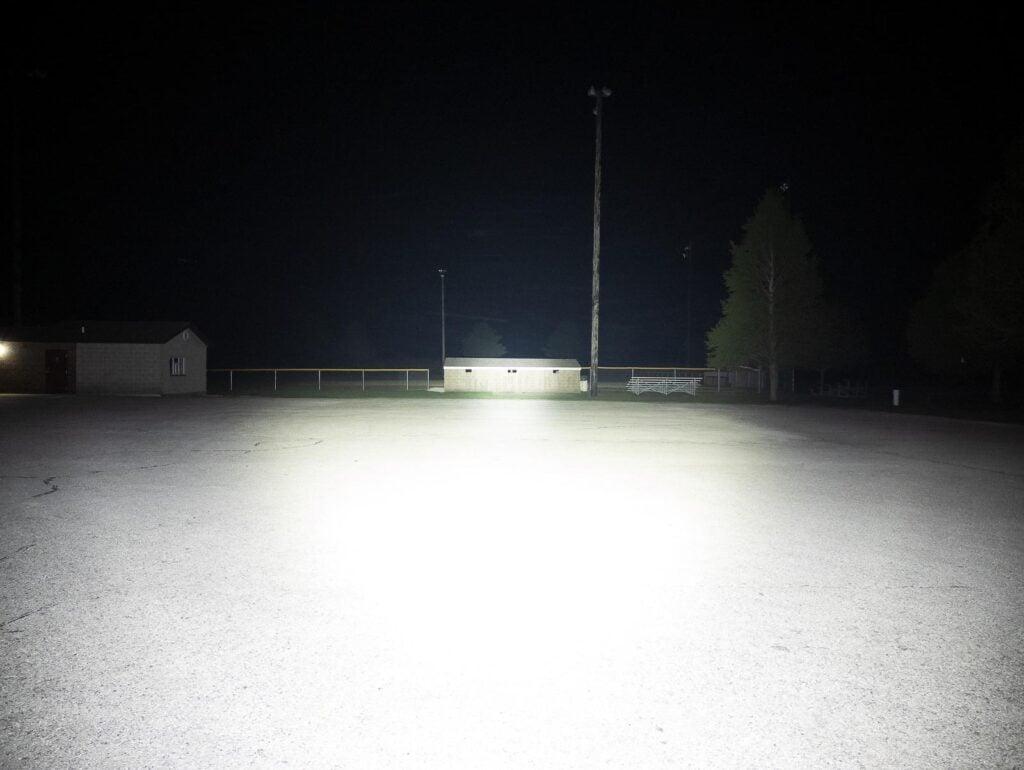
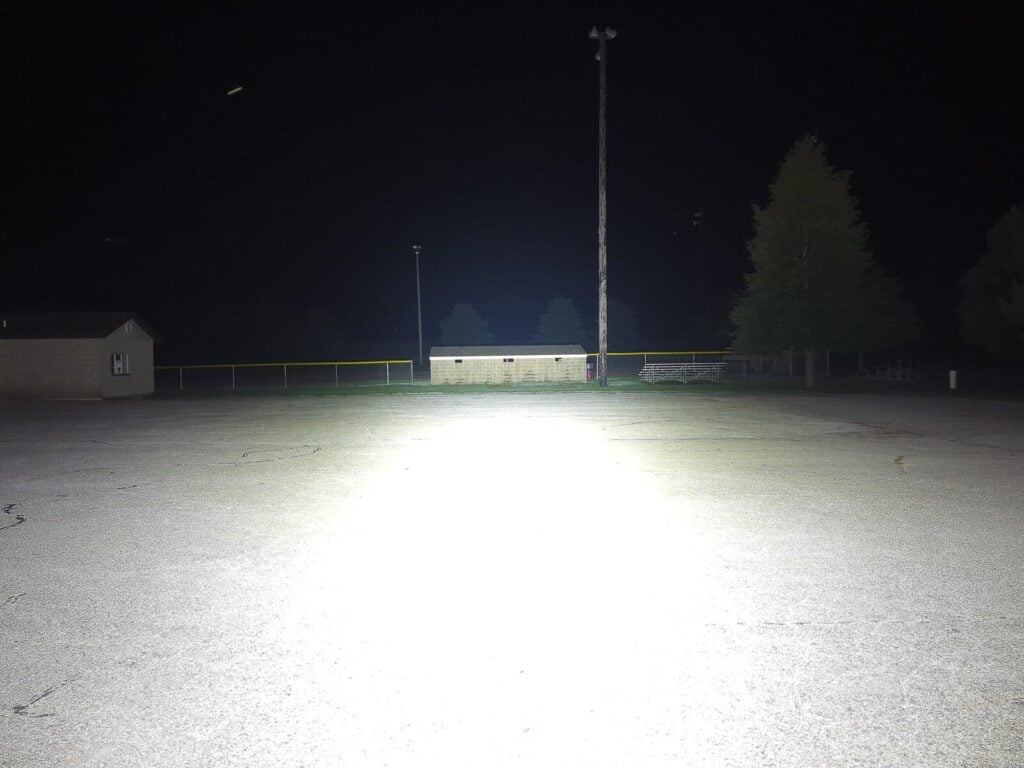
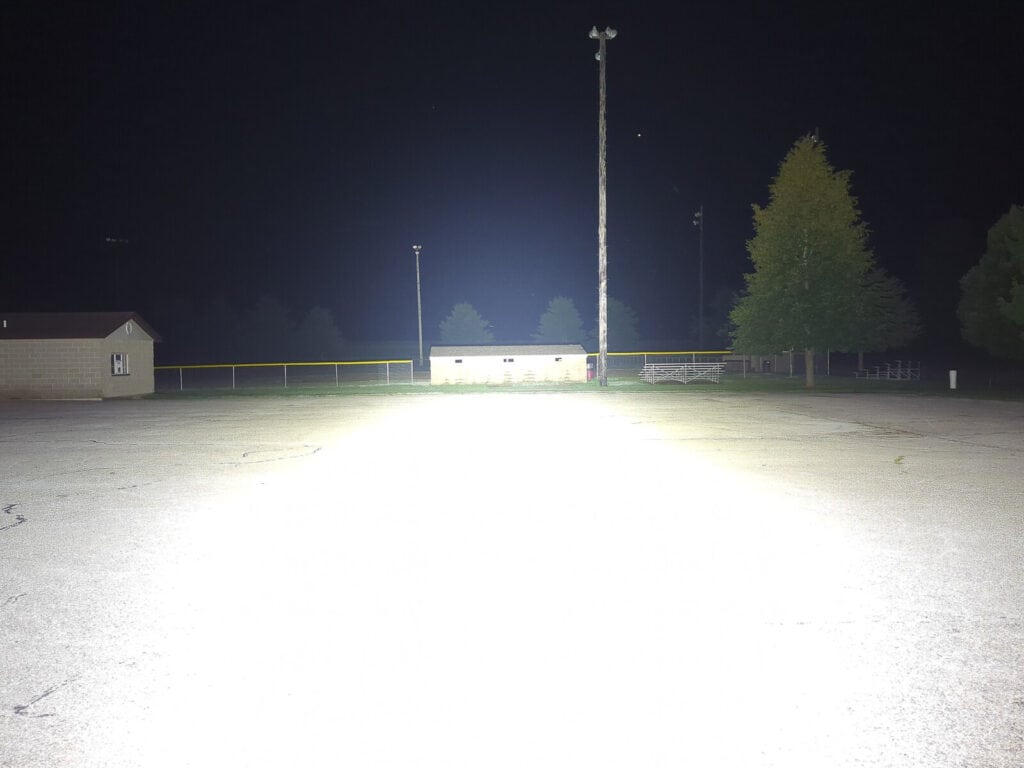
Disclaimer: This flashlight was sent to me for review at no cost by Nealsgadgets. I have not been paid to review, nor have I been holding back on problems or defects.
Final Verdict
Pros
- Impressive 60,000 lumens
- Handle with built-in button
- Fast USB-C charging/discharging
Cons
- Gets crazy hot
- Misses intensity spec by a large margin
- UI bugs / inconsistencies
Explanation on star ratings:
1: Avoid: a match would be a better choice – 2: Poor: significant defect or issues; almost unusable – 3: Average: some defects or issues; but still usable 4: Good: recommended (minor issues) – 5: Great: highly recommended

3.5 stars: ★★★⋆
While our star rating provides a reliable indicator, we encourage you to read the full review to make an informed decision based on your own needs and preferences.
Let’s cut to the chase – the HaikeLite HK08 is jaw dropping. The flashlight itself is big and beefy. And 60,000 confirmed lumens? It’s enough to turn night into day. If that’s all you care about, then stop reading and go buy one. But if you’re looking for a polished, quality flashlight… the HaikeLite HK08 probably isn’t for you. The output drops rapidly and can’t sustain 4,000 lumens without getting scorchingly hot. The UI seems to have some annoying bugs with mode count and spacing. And I couldn’t measure anywhere near HaikeLite’s intensity (candela) claim. If those kinds of things matter to you, then you might want to keep browsing 1Lumen for other options.
Buy your Haikelite HK08 with a discount
Get 15% off, by using our exclusive 1lumen discount code: 1lumen711
1lumen selects and reviews products personally. We may earn affiliate commissions through our links, which help support our testing.